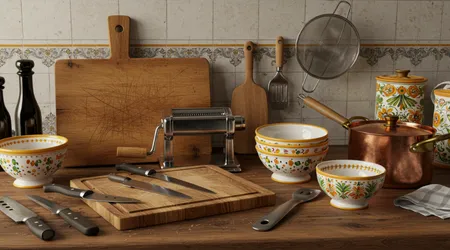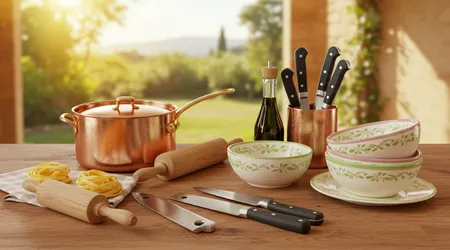Essential tools in Italian cooking

Essential tools in Italian cooking They are the beating heart of every kitchen that aspires to create authentic dishes rich in tradition.
Announcements
These aren't just tools, but true allies that transform simple ingredients into gastronomic masterpieces.
Italian cuisine, celebrated throughout the world, is based on techniques passed down through generations and on tools that embody functionality and history.
But what are the items that cannot be missing in a modern Italian kitchen in 2025?
This article explores essential utensils, offering practical insights and reflections on how they elevate the culinary art, with an eye on tradition and innovation.
Announcements
Italian cuisine isn't just food, it's culture. Every region, from North to South, has its own secrets, but the tools unite.
A well-sharpened knife or a cast iron pot tell stories of grandmothers and starred chefs.
In 2025, interest in home cooking is growing: according to a 2024 Coldiretti survey, 73% of Italians cook at home at least five times a week.
The essential tools in Italian cuisine They are therefore more relevant than ever, not only for practicality but to connect with the roots.
Let's get ready to discover which tools make the difference, with concrete examples and tips for an authentic experience.
The knife: precision as an art
A quality knife is an extension of the cook's hand. In Italy, a chef's knife with a 20 cm blade is essential.
Chopping tomatoes for salsa or finely slicing ham requires precision. Brands like Sanelli and Victorinox are synonymous with reliability, with blades that last for years.
Let's not underestimate smaller knives. A paring knife is perfect for peeling garlic or garnishing vegetables.
++ How to avoid mistakes when making desserts
Maintenance is crucial: a manual sharpener or whetstone keeps the blade sharp. Think of a knife as a magic wand: without it, the magic doesn't happen.
Tradition meets innovation in handcrafted knives. In regions like Sardinia, Pattada knives are still hand-forged.
Investing in a good knife isn't just practical, it's also a tribute to history. How many memorable dishes begin with a perfect cut?

Pots and pans: the heart of heat
The right cookware can transform a dish. For pasta, a large stainless steel pot is essential: it must boil without sticking.
Cast iron, on the other hand, is ideal for slow sauces, such as a Bolognese ragù, thanks to the even distribution of heat.
Nonstick pans are useful, but a cast iron skillet is a timeless classic. Perfect for frying or sautéing, it develops a natural coating that enhances flavors.
See also: Basic bread making techniques
Brands like Le Creuset offer durable options, but even a handcrafted Italian pan makes a difference.
The choice of material is a matter of balance. Aluminum conducts heat quickly, but steel is more durable.
A kitchen without versatile cookware is like an orchestra without a conductor: the result will never be harmonious.
Pasta Tools: The Soul of Italy
Pasta is the symbol of Italian cuisine, and essential tools in Italian cuisine to prepare it are unique.
A manual pasta machine, like those from Marcato, is a must for perfect pasta sheets. Kneading by hand is a ritual, but a stand mixer can make it easier.
For filled pasta, like ravioli or tortellini, precise molds are needed. A long, sturdy wooden rolling pin is essential for rolling out the dough.
In Emilia-Romagna, pasta makers use beech rolling pins for a flawless texture.
Don't forget the colander. A steel model with ergonomic handles makes draining easier without burning yourself.
Making pasta without these tools is possible, but why give up perfection?
Precision Tools: Scales and Measuring Cups
Italian cooking is intuitive, but precision matters. A digital scale, accurate to the gram, is essential for baking desserts or bread.
Steel or glass measuring cups ensure exact doses for sauces or dressings.
Grandmothers used to weigh by eye, but in 2025, technology helps. A smart scale, like those from Zwilling, connects to your phone for guided recipes. Precision isn't about fussiness, it's about respecting the ingredients.
A kitchen thermometer is another great ally. Checking the temperature of your frying oil or pizza oven can prevent disasters.
Small tools, big results: this is the magic of Italian cuisine.
Traditional tools: mortar and grater
The marble mortar is a symbol of authenticity. Crush basil, pine nuts, and garlic for the perfect Genoese pesto.
The hand-made texture is inimitable compared to a blender. It's hard work, but the flavor is worth it.
The four-sided grater is versatile: Parmesan, lemon zest, or nutmeg. Stainless steel models last a lifetime.
Alternatively, a Microplane offers fine cuts for discerning chefs.
These instruments evoke memories. The sound of the pestle or the smell of grated Parmesan cheese bring back family meals.
Tradition lives in the details, and the essential tools in Italian cuisine they guard it.
Innovation in the kitchen: modern tools

Technology doesn't betray tradition, it enriches it. An immersion blender, like those from Bamix, is perfect for creamy soups or smoothies. Save time without sacrificing quality.
Steam ovens, increasingly common, cook vegetables while retaining nutrients and flavor.
Brands like Smeg offer compact models for home kitchens. Modernity is an opportunity, not a threat.
Ceramic knives are also gaining popularity. Lightweight and sharp, they are ideal for precise cuts. essential tools in Italian cuisine they evolve, but the soul remains the same.
Practical examples: tools in action
Imagine making lasagna. A sharp knife chops onions for the soffritto, and a cast iron pot cooks the ragù for hours.
The pasta machine rolls out thin sheets, while a grater sprinkles Parmesan cheese. Each tool has a role, like actors in a well-directed play.
Or, think of a tiramisu. A scale measures the mascarpone, an immersion blender whips the cream, and a silicone spatula spreads it without waste.
The essential tools in Italian cuisine they transform ideas into reality.
Table: Comparison of tool materials
| Material | Advantages | Disadvantages | Ideal use |
|---|---|---|---|
| Stainless Steel | Durable, does not rust | Heavy, medium-high cost | Pots, knives, graters |
| Cast iron | Uniform heat distribution | Heavy, requires maintenance | Sauces, fried foods |
| Wood | Natural, does not damage surfaces | Absorbs odors, less hygienic | Rolling pins, cutting boards |
| Ceramic | Lightweight, precise cut | Fragile, high cost | Knives, baking dishes |
Conclusion: tools as a bridge between past and future
The essential tools in Italian cuisine They are more than objects: they are guardians of stories, flavors and traditions.
It doesn't matter if you use your grandmother's mortar or a smart oven, what matters is the heart you put into your dishes.
In 2025, Italian cuisine is experiencing a renaissance, with more and more people rediscovering the pleasure of cooking.
Investing in quality tools is an act of love towards yourself and those who will sit at your table.
Why just cook, when you can create? essential tools in Italian cuisine They are your passport to an endless culinary journey.
Choose carefully, experiment, and let each dish tell your story. Italian cuisine is alive and well, and you are the next chapter.
Frequently Asked Questions
What are the basic tools for Italian cuisine?
A chef's knife, steel saucepan, cast iron skillet, rolling pin, grater, and digital scale are essential to get started.
Can I use modern tools without losing authenticity?
Yes, tools like immersion blenders or steam ovens respect tradition, optimizing time and results.
